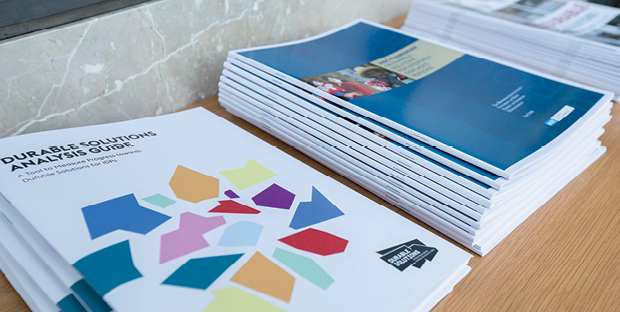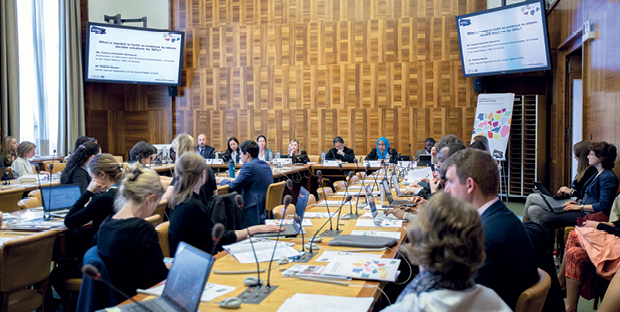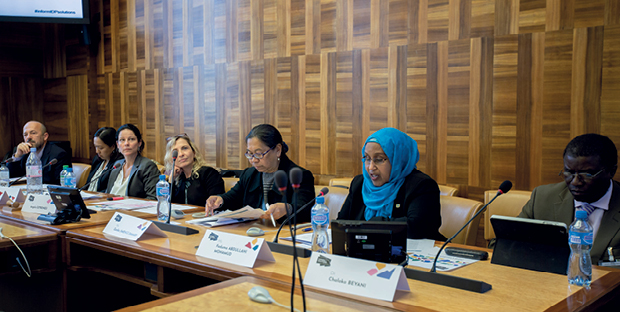Securing durable solutions for internally displaced persons is a major challenge, as in many situations the process has become stalled, or displacement cyclical. One of the most pressing questions in this context has been how to create an agreed-upon and shared evidence-base to inform coordinated responses of all actors working to support durable solutions, as well as how to measure progress towards solutions.
On 16 April 2018, during a Geneva-based event moderated by Cecilia Jimenez-Damary, Special Rapporteur on the human rights of IDPs, we launched two practical tools aimed to guide governments and other actors to acquire solid evidence to inform durable solutions for IDPs: the Durable Solutions Indicator Library and the Analysis Guide.
These tools are the result of a multi-stakeholder initiative over the past three years to operationalise the IASC Framework on Durable Solutions for IDPs. This remarkable achievement also marks the 20th anniversary of the Guiding Principles on Internal Displacement, which guide legal, policy and institutional responses to protect and promote the human rights of IDPs.

The Durable Solutions Analysis Guide.
Initiated in 2015, the interagency project Informing Responses to Support Durable Solutions for IDPs aimed to support governments and their humanitarian and development partners in producing a sound evidence-base that can inform effective joint action in the pursuit of solutions for IDPs. It is the fruit of a collaborative effort led by the Special Rapporteur on the human rights of IDPs, carried out in collaboration with a Technical Steering Committee comprising multiple development and humanitarian partners and academic experts, and coordinated and implemented by JIPS.

The project set-up and members of the Technical Steering Committee (TSC).
Several partners in the field, including Government representatives from Somalia, Colombia and Sudan, also contributed to the project through their experiences. The project tested the indicators and analysis approach through various ‘real-life’ displacement data collection exercises.
The project outcomes underline the importance of a collaborative approach to durable solutions analysis, including the participation of IDPs and displacement-affected communities in shaping this evidence-base.
In the launch event, we asked communities, experts and high-level representatives what is actually needed for comprehensive and sound durable solutions analysis. Here is what they answered:

From the right: Dr. Chaloka Beyani, Ambassador Faduma Abdullahi Mohamud, Ms. Cecilia Jimenez-Damary, Dr. Angela Cotroneo, Ms. Elizabeth Eyster, Ms. Henny Ngu, Mr. Igor Cvetkovski. Also on the panel were Natalia Krynsky Baal, Laura Ronkainen and Khadra Elmi.
Progressing towards durable solutions is challenging for a number of reasons, including the difficulty of addressing the interests of different stakeholders and the specificities of each context. As highlighted by Dr. Chaloka Beyani, former Special Rapporteur on the human rights of IDPs, involving multiple stakeholders is often time-consuming and brings along various coordination challenges. However, it is a key step to ensure a successful process towards durable solutions.
In particular, national and local authorities need to participate in (and lead, when possible) the data and analysis gathering processes. This is crucial in order to ensure that results and analysis have the strongest impact on national policy and planning processes.
A valuable concrete example was presented by Faduma Abdullahi Mohamud, Ambassador to Switzerland and Permanent Representative of Somalia to the United Nations Office in Geneva: despite the many challenges that Somalia is facing, Government institutions are investing considerably in finding durable solutions for IDPs. Examples include:
Working closely with IDPs and displacement-affected communities from the very early stages of a crisis is fundamental. Through a video message from El Fasher, Sudan, representatives of IDP communities emphasised the value of durable solutions analysis for them, as well as their eagerness and strong interest to fully participate in the process.
As also highlighted by Dr. Angela Cotroneo, Adviser on Internal Displacement at ICRC, failing to involve IDPs might result in designing inadequate interventions, or can even lead to renewed displacement. A holistic approach, taking displaced as well as host communities into account, is integral for designing sustainable responses and meaningful advocacy on behalf of the affected communities.
In order to understand the extent to which solutions to displacement have been achieved, analysis of protection and socio-economic data need to be combined. This is because, in certain cases, it is possible for protection issues to persist even when from a socio-economic perspective IDPs may (no longer) be specifically affected by displacement.
Elizabeth Eyster, Chief of the IDP Section at UNHCR, shared the example of El Salvador: despite the difficult circumstances causing displacement, findings from a recent profiling exercise in the country showed that IDPs tended to remain close to their places of residence.
While they were thus able to maintain their previous economic activities, they still had significant protection needs due to their displacement (trauma, continued fear, risk of re-displacement, etc.). A combined protection and socio-economic lens allowed for a deeper understanding of the situation.
Genuinely sustainable development cannot be achieved if IDPs are left behind. For this reason, we need quality evidence that can inform national development planning processes and fulfilment of the Sustainable Development Goals (SDGs).
As elucidated by Henny Ngu, Policy Specialist on Livelihoods and Displacement at UNDP, the first step is to understand why and how IDPs and host communities are vulnerable, as well as what are the best ways in which they can be supported to be resilient to future crises. Secondly, it is important to make sure that data and evidence on internal displacement also contribute to sustainable programming with longer-term goals.
The Durable Solutions Indicator Library is aligned with the indicator framework for the SDGs. As such it is a valuable resource that can directly inform SDG implementation in a manner that ensures that vulnerable groups are taken into account.
As explained by Igor Cvetkovski, Land, Property and Reparations Officer at IOM, beyond “what information is needed, we also need to think of how we should collect it”. Displacement situations are often complex, and hence support to durable solutions – and therefore the process of acquiring the necessary evidence that informs them – requires a wide range of partners to work together, as well as getting diverse expertise around the table. In addition, it is important that this collaboration starts from a very initial stage to build a common and comprehensive picture that can inform joint action.
As outlined in the IASC Framework on Durable Solutions for IDPs, for example, durable solutions also have an important peace-building dimension, and it is thus important to integrate transitional justice into the analytical framework alongside development and humanitarian contributions.
The launch of the Indicator Library and Analysis Guide represent a significant step forward on improving the quality of evidence to inform durable solutions processes.
Structured around the eight durable solutions criteria of the IASC Framework, the Indicator Library allows users to select the themes and indicators that are relevant to their specific contexts. The Analysis Guide explains step-by-step how a comprehensive durable solutions analysis can be implemented, and how to monitor progress towards durable solutions over time.
The significant contributions from a large number of experts, organisations and institutions throughout this project have ensured that the outcomes are adequately rigorous, and at the same time adequately practical. At JIPS we are committed to keep working on enhancing data and analysis to support durable solutions to displacement, with a strong focus on collaboration and community engagement.